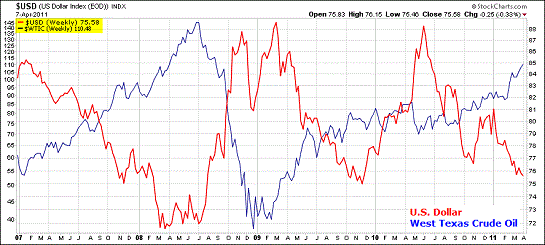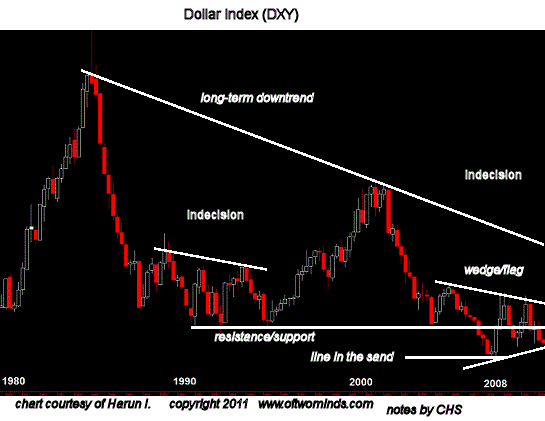The Fed's Most Dangerous Game: Checkmate
The Fed can only choose the least-worst option now: either destroy the real economy by sinking the dollar below support and unleashing the Inflation Monster, or abandon the "risk trade" stock market rally. The Fed's game plan--sink the U.S. dollar to goose corporate profits, reinflate asset prices and create "modest inflation"--is now the most dangerous game on Earth. As overleveraged assets from real estate to stocks imploded in 2008 and early 2009, the Federal Reserve rushed to flood the global economy with zero-interest dollars. This did a number of things the Fed reckoned were necessary: 1. It gave U.S. banks and other insolvent financial institutions an unlimited pool of money to borrow at zero interest and leave on deposit at the Fed, where it earned risk-free interest. 2. It enabled a vast global "carry trade" in dollars: speculators could borrow unlimited dollars at no cost, and then deploy the cash around the world to chase higher yields in stocks, commodities, etc. 3. It allowed banks to lend profitably in the U.S., as their cost of money was reduced to essentially zero, and to pour "hot money" into U.S. stocks, creating a virtuous cycle of ever-rising equity prices. 4. With the bulk of U.S. corporations' growth and earnings coming from overseas sales, then a plummeting dollar boosted their profits effortlessly, further goosing U.S. stocks. 5. With savings earning nothing, U.S. investors were driven into the "risk trades" of the stock market and commodities, a flow of funds which reinflated asset bubbles. This reinflation was critical to foster the appearance of widespread "recovery" via the "wealth effect" of rising asset prices. 6. A rising stock market not only offered an illusion of "growth" but it bailed out pension funds and set the stage for Wall Street to reap billions of dollars from the resurgence of mergers and acquisitions, IPOs and derivatives. The basic idea was to extend the game plan which had worked in the last banking crisis in the early 1980s: don't force the banks to declare their losses, but "extend and pretend" while offering them risk-free ways to bank billions in profits. The goal was to enable the banks to recapitalize "painlessly" on the backs of consumers and taxpayers. The other goal of the plan was to create some modest inflation by brute-force depreciation of the nation's currency. This inflation would be "good" because it would enable debtors to pay off their debts with cheaper dollars, and it would also serve to reinvigorate the "animal spirits" of borrowing and spending the Fed views as the bedrock of the "permanent growth" economy. If you're confident that your cash will be worth less next year, you're highly incentivized to spend it now rather than see its purchasing power decline. But in choosing to depreciate the dollar, the Fed engaged in a high-stakes game with potentially devastating consequences. By pushing the dollar down to near-historic lows, the Fed now risks a destabilizing criticality: if the dollar breaks key support levels, then traders and holders everywhere will have great uncertainties about how low it might drop. That will encourage them to sell their dollars immediately rather than hold on to find out how low it might fall. As we can see in this chart, the dollar's decline has not occurred in a vaccum: when the dollar declines, oil and gasoline shoot up. The dollar and oil (and other essential commodities) are on a see-saw, for oil exporters simply raise prices to compensate for the loss of purchasing power as the dollar declines. (Chart courtesy ofdshort.com.) The Fed is now trapped: if it crushes the dollar any lower, then oil will jump toward its 2008 highs around $140/barrel--a level that triggers recession in the "real" U.S. economy. A recession will disembowel the "recovery" and all the rest of the Fed's carefully nurtured props of "prosperity." The unintended consequences of the Fed's inflationary plan to depreciate the dollar is evident everywhere in skyrocketing food and energy costs. Destroying the dollar has sparked destabilizing global inflation which threatens to spin out of control. But if they let the dollar rise, then their precious stock market rally implodes. And what's left of the mirage of "recovery" if the "wealth effect" evaporates? Zip, zero, nada. Here is a long-term chart of the dollar, courtesy of Harun I. I have added a few notes. Note the long-term downtrend. No wonder 97% of the pundits and punters are bearish. The "line in the sand" is not far below current levels: if the Fed pushes the dollar below this level, technically there is no visible support, and oil will be on its way to $200/barrel, far past the point it pushes the economy into recession. Many technicians have noted the wedge/flag pattern in the dollar's recent action.Price usually breaks out of a flag in a major move either up or down. Also of interest is the extended period of indecision traced out between 1988-1994. In a macro perspective, this mirrored the trends and counter-trends in the U.S. and global economy. The dollar has again traced out a similar period of indecision since 2004--roughly seven years. That suggests the possibility that a key inflection point is close at hand--the same conclusion drawn from the flag-pennant-wedge formation. The Fed now has to choose between two bad options: either keep pushing down the dollar and let oil's inevitable rise trigger a recession, or let the dollar recover and watch stocks crater as the "risk trades" reverse. If the dollar Bears have to cover their short bets, the ensuing rally in the dollar might well be explosive and self-reinforcing. I addressed this possibility in A Contrarian Take on the Dollar's Demise (March 25, 2011). If the Fed lets the dollar depreciate in an uncontrolled fashion, then we may well end up with the hyper-inflation (loss of faith) that many expect. My question remains: what course of action will benefit those issuing the whispered orders to their lackeys and toadies on the Fed and in Congress? Will a disorderly and disruptive collapse of the dollar serve the Financial Power Elites' best interests? I don't see how it would. Rather, I see it wreaking great damage on their holdings. Thus it wouldn't surprise me in the least were the Fed to shock the markets with a "surprise" rate increase within the next few weeks or months. Destroying the real economy to maintain the "risk trades" is a foolhardy way to close down a lose-lose position. Harun sheds additional light on the broader contexts in his commentary: What happens if rates rise? At the time of a loan the principle is created, the interest is not, therefore, everyone who needs to borrow tremendous amounts of money to service existing debt (most of western Europe and the US) will not be able to, therefore there will be cascading defaults of unprecedented amounts. Governments would collapse seemingly overnight. If the game is to continue, there must be enough credit expansion create enough "money" to make interest payments and create so called "growth". Which brings us to... Inflating the currency: As with the chess player above, it merely holds off the inevitable. Why is it "different" this time? Why has the system become so intolerant to the smallest adverse moves? Answer: Leverage. At 1:1 leverage 100 percent has to be lost to achieve ruin. At 1:2 50 percent must be lost. Jump to 1:40 leverage and only a 2 percent loss brings about ruin. So what is our leverage? First, we must stop this version of off balance sheet accounting. This version of private household accounting keeps off the liability side of its balance sheet the federal deficit. It is also further skewed by dispersing the federal deficit amongst every person in the US. When is the last time a person bought a house and turned to their infant in the stroller happily using its toes as a pacifier and said, "your portion of this mortgage is $25,000.00?" If total debt, private and public were carried on household balance sheets and divided only among the productive, i.e. employed, the reality of it would change the conversation dramatically. What would be realized is that the US and most of Western Europe is hopelessly over-leveraged and it is only a matter of time before the structural instability created by this leverage manifests in some unpleasant way. And no, the answer does not lie in a one world currency. Without getting rid of current levels of debt we would run into Dr. Bartlett's analogy of microbes doubling every minute in a bottle. How much time would it take to fill three more bottles. Well, in the first minute the first new bottle would be full, and in the next minute the two remaining bottles would be full (remember, they are doubling). So if debt levels remain the same debt must double in order to service existing debt and providing growth. This is why California and other states keep running into problems they thought they fixed. While they make minimalist cuts to spending those cuts are outstripped by the exponential growth of the interest on existing debt. This is also why the current deal in congress is an insult to every intelligent adult in America. Interest on the debt will consume that $33 billion spending cut in no time at all. BTW, this is the same reason why discovering a brand new super-giant oil field will not matter if demand growth continues at a constant rate. Any and all growth is exponential and therefore will continuously double at some point. The DXY yearly chart (not shown) shows that bulls have not been able to force a test of the previous three year highs. The quarterly chart shows bears have been able to push price down breaking quarterly lows to important support. What happens next depends. If historical support is broken then the probability increases that price will continue down and things get really interesting. If support holds or if price dips below support enough to get those stops and then move back up through support turned resistance the probability increases there will be a sharp rally as bears cover. But this tells only a portion of the story. Look at what has happened while the DXY has been range bound. In the case of energy (and just about all other commodities) the DXY has underperformed dramatically. More specifically if you stayed in cash, the cost of gasoline has gone up four fold since the bottom in 2009. Do this exercise across the commodity spectrum and the results will be roughly the same. So the question is, how long can can the current course be maintained? Thank you, Harun. As I wrote Harun, it's Fed Chairman Ben Bernanke's move, but he faces a cruel dilemma: if he moves his queen out of check, he will lose his protective knight. There are only bad choices left, Mr. Bernanke. That's the consequence of playing the world's most dangerous game with the dollar, grain and oil. Of Two Minds Kindle edition: Of Two Minds blog-Kindle

Have you ever played chess against someone who refuses to resign even though he or she is down so many pieces chances of winning are zero. All they do is keep moving out of check until there is no more room and they are finally checkmated?
Readers forum: DailyJava.net.
Order Survival+: Structuring Prosperity for Yourself and the Nation (free bits) (Mobi ebook) (Kindle) or Survival+ The Primer (Kindle) or Weblogs & New Media: Marketing in Crisis (free bits) (Kindle) or from your local bookseller.Thank you, Ed D. ($5/mo), for your superbly generous subscription to this site-- I am greatly honored by your support and readership. Thank you, Matthew W. ($200), for your outstandingly generous contribution to this site-- I am greatly honored by your support and readership.



























